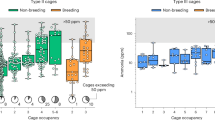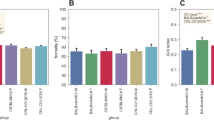Abstract
Before animal research facilities began using individually ventilated cage (IVC) systems for mice, cages were often changed one or more times per week. When using IVC systems, however, it is standard practice to change cages only once every 2–3 weeks. When deciding how often to change cages, personnel may consider the cost of labor needed to change the cage, as well as the cage type and bedding type, rather than animal preference or concern for animal well-being. The authors carried out a simple preference test in groups of mice. Mice were allowed to choose between an unsoiled cage and cages that had not been changed for 1 d, 7 d or 14 d. When evaluating where mice positioned their nests and the amount of time mice spent in the various cages, the authors found that the mice preferred the unsoiled cage. Younger mice (<150 d old) showed a stronger preference for the unsoiled cage than did older mice (>150 d old). Further studies are warranted to evaluate mice's preferences for cages changed at different intervals and to determine whether prolonging the interval between cage changes has any negative effects on mice.
This is a preview of subscription content, access via your institution
Access options
Subscribe to this journal
We are sorry, but there is no personal subscription option available for your country.
Buy this article
- Purchase on Springer Link
- Instant access to full article PDF
Prices may be subject to local taxes which are calculated during checkout

Similar content being viewed by others
References
Institute of Laboratory Animal Resources. Guide for the Care and Use of Laboratory Animals 6th edn. (National Academy Press, Washington, DC, 1985).
Institute of Laboratory Animal Resources. Guide for the Care and Use of Laboratory Animals 7th edn. (National Academy Press, Washington, DC, 1996).
Guide to the Care and Use of Experimental Animals Vol. 1. 2nd edn. (eds. Olfert, E.D., Cross, B.M. & McWilliam, A.A.) (Canadian Council on Animal Care, Ottawa, Canada, 1993).
Reeb, C. et al. Microenvironment in ventilated animal cages with differing ventilation rates, mice populations, and frequency of bedding changes. Contemp. Top. Lab. Anim. Sci. 37, 43–49 (1998).
Reeb-Whittaker, C.K. et al. The impact of reduced frequency of cage changes on the health of mice housed in ventilated cages. Lab. Anim. 35, 58–73 (2001).
Rosenbaum, M.D., VandeWoude, S. & Johnson, T.E. Effects of cage-change frequency and bedding volume on mice and their microenvironment. J. Am. Assoc. Lab. Anim. Sci. 48, 763–773 (2009).
Blom, H. Evaluation of Housing Conditions for Laboratory Mice and Rats, PhD thesis, University of Utrecht, Utrecht, The Netherlands (1993).
Sherwin, C.M. Preferences of laboratory mice for characteristics of soiling sites. Anim. Welf. 5, 283–288 (1996).
Blom, H.J.M. et al. Description and validation of a preference test system to evaluate housing conditions for laboratory mice. Appl. Anim. Behav. Sci. 35, 67–82 (1992).
Van Den Broek, F.A.R., Omtzight, C.M. & Beynen, A.C. Whisker trimming behaviour in A2G mice is not prevented by offering means of withdrawal from it. Lab. Anim. 27, 270–272 (1993).
Van Loo, P.L.P., van de Weerd, H.A., Van Zutphen, L.F. & Baumans, V. Preference for social contact versus environmental enrichment in male laboratory mice. Lab. Anim. 38, 178–188 (2004).
Sherwin, C.M. Observations on the prevalence of nest-building in non-breeding TO strain mice and their use of two nesting materials. Lab. Anim. 31, 125–132 (1997).
Olsson, I.A. & Dahlborn, K. Improving housing conditions for laboratory mice: A review of 'environmental enrichment'. Lab. Anim. 36, 243–270 (2002).
Rogers, D.C. et al. Use of SHIRPA and discriminant analysis to characterise marked differences in the behavioural phenotype of six inbred mouse strains. Behav Brain Res. 105, 207–217 (1999).
Acknowledgements
We thank the Johns Hopkins Center for Alternatives to Animal Testing and the Animal Welfare Institute for supporting this project. We also thank Dr. Kathy Baylis, Associate Professor, Land and Food Systems, University of British Columbia for help with the statistical design and analysis.
Author information
Authors and Affiliations
Corresponding author
Ethics declarations
Competing interests
The authors declare no competing financial interests.
Rights and permissions
About this article
Cite this article
Godbey, T., Gray, G. & Jeffery, D. Cage-change interval preference in mice. Lab Anim 40, 225–230 (2011). https://doi.org/10.1038/laban0711-225
Received:
Accepted:
Published:
Issue Date:
DOI: https://doi.org/10.1038/laban0711-225



